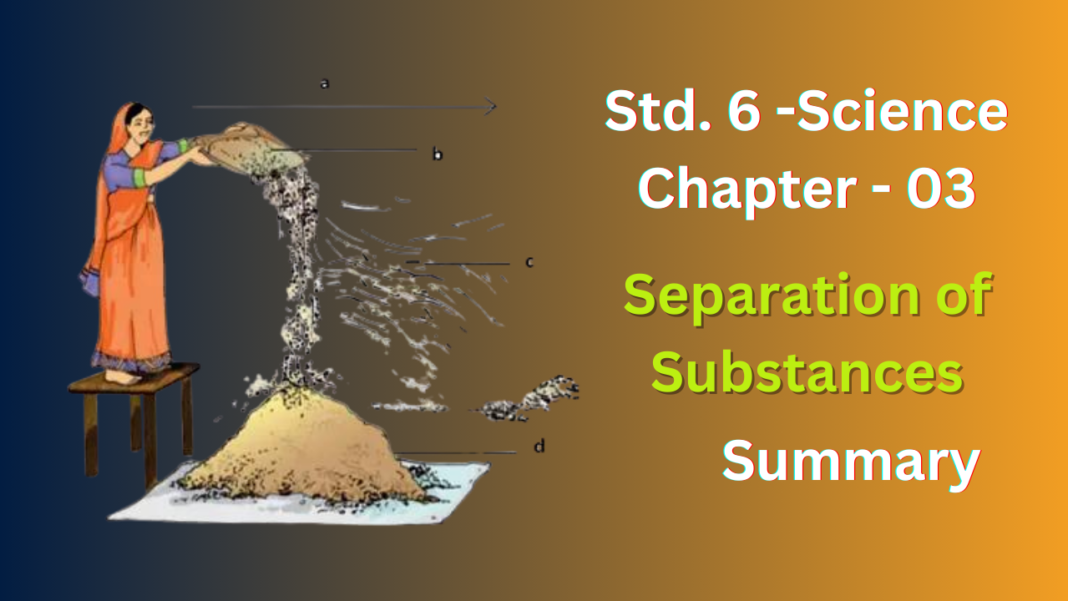NCERT solutions for Class 6 Science Chapter 3
The chapter “Separation of Substances” explores various methods used to separate mixtures into their individual components. NCERT solutions for Class 6 Science Chapter 3:
Why Separate?
Separating mixtures allows us to obtain pure substances for various purposes, like extracting salt from seawater or removing impurities from sand.
Separation Methods:
Handpicking: Used for removing larger, visible components from a mixture, like picking stones from grains.
Sieving: Employs a sieve with mesh to separate particles based on size. For example, sieving flour to remove larger bran particles.
Decantation: Useful for separating immiscible liquids (don’t mix well) with different densities. The heavier liquid (e.g., water) is poured off, leaving the lighter liquid (e.g., oil) behind.
Filtration: Uses a filter (e.g., paper or cloth) to separate a solid from a liquid. This method is used to separate tea leaves from tea or sand from water.
Evaporation: Involves heating a solution to evaporate the liquid, leaving the dissolved solid behind. This is used to obtain salt from seawater.
Additional Points:
Choosing the right method depends on the properties of the components in the mixture.
Some mixtures require combining multiple methods for complete separation.
Understanding separation techniques is crucial in various fields, including chemistry, food processing, and medicine.
NCERT solutions for Class 6 Science Chapter 3
Exercises :
- Why do we need to separate different components of a mixture? Give two examples.
Ans : 1. To obtain pure substances:
In many cases, we need individual components of a mixture in their pure form for specific purposes.
2. To remove unwanted components:
Sometimes, a mixture contains unwanted or harmful components that need to be removed.
3. To isolate components with specific properties:
Different components of a mixture often have unique properties that we want to utilize individually.
4. To improve the quality or usefulness of a mixture:
Separation techniques can help refine or enhance a mixture for its intended use.
Examples:
- Separating Salt from Seawater
- Separating tea leaves from tea
- Obtaining sugar from sugarcane juice
2. What is winnowing? Where is it used?
Ans : Winnowing is a traditional agricultural technique used to separate grains from the chaff, the lighter husks that surround the edible kernels. It relies on the differential weight and wind resistance of these components.
Where is it used:
Winnowing is a low-tech and inexpensive method, making it particularly useful in developing regions and traditional farming practices. It is commonly used to separate various grains, including:
- Wheat
- Barley
- Oats
- Rice
3. How will you separate husk or dirt particles from a given sample of pulses before cooking
Ans : Method: Winnowing
Equipment:
- A large, flat tray or plate
- A clean surface for collecting clean pulses
Steps:
- Spread the pulses in a thin layer on the tray.
- Hold the tray at shoulder height above the clean surface.
- Tilt the tray slightly and gently tap it with your hand or a spoon.
- Create a gentle breeze by fanning yourself or using a fan in a controlled manner.
- As you stir the pulses with your hand, the heavier pulses will fall straight down onto the clean surface.
- The lighter husk and dirt particles will be carried away by the wind and fall away from the clean pulses.
- Repeat steps 2-6 until you observe minimal debris remaining with the pulses.
4. What is sieving? Where is it used?
Ans : Sieving is a separation technique used to separate particles of different sizes from a mixture. It relies on a sieve, which is a tool with a mesh or perforated surface.
Where is it used
Sieving is a versatile technique used in various applications, including:
- In the kitchen:
- Separating flour from bran in wheat.
- Removing lumps from powdered ingredients like sugar or cocoa powder.
- Sifting powdered sugar for baking.
- In construction:
- Separating sand particles of different sizes for specific construction purposes.
- Removing gravel from sand for use in concrete mixtures.
- In science:
- Separating different sized particles in a chemical mixture for analysis.
- Grading sand samples for research purposes.
5. How will you separate sand and water from their mixture?
Ans : Method 1: Sedimentation and Decantation
Equipment:
- A tall, transparent container (e.g., glass jar, beaker)
- Another container for collecting the water
Steps:
- Pour the sand-water mixture carefully into the tall container.
- Allow the mixture to stand undisturbed for some time (a few minutes to an hour, depending on the amount of sand).
- During this time, the sand will settle down at the bottom of the container due to its greater density compared to water.
- The water will remain clear on top.
- Tilt the container carefully without disturbing the settled sand.
- Slowly pour the clear water into the other container, stopping before the sand starts to move.
Method 2: Filtration
Equipment:
- Funnel
- Filter paper (coffee filter, paper towel)
- Another container for collecting the water
Steps:
- Place the filter paper in the funnel.
- Position the funnel over the other container.
- Slowly pour the sand-water mixture through the filter paper.
- The water will pass through the filter paper, leaving the sand trapped on top.
- The filtered water will be collected in the container below.
6. Is it possible to separate sugar mixed with wheat flour? If yes, how will you do it?
Ans : Yes, it is possible to separate sugar mixed with wheat flour using the technique of sieving. This method relies on the difference in the size of the sugar crystals and flour particles.
Here’s how you can separate sugar and wheat flour:
Equipment:
- A sieve with a mesh size appropriate for flour (typically around 120 mesh)
- Two bowls or containers
Steps:
- Place the mixture of sugar and wheat flour on the sieve.
- Gently shake the sieve back and forth or tap it lightly with a spoon.
- The finer flour particles will pass through the mesh of the sieve and fall into one of the bowls placed below.
- The larger sugar crystals will remain on top of the sieve in the other bowl.
- You can repeat the shaking and tapping if necessary to ensure complete separation.
7. How would you obtain clear water from a sample of muddy water?
Ans : You can obtain clear water from a sample of muddy water using the technique of filtration. This method utilizes a filter to separate the solid impurities (mud) from the liquid (water).
Here’s how to perform filtration:
Equipment:
- Funnel
- Filter paper (coffee filter, paper towel)
- Two containers (one for the muddy water and one for the filtered water)
Steps:
- Fold the filter paper (if using) to fit inside the funnel.
- Place the funnel over the empty container for collecting the filtered water.
- Pour the muddy water slowly and carefully into the funnel.
- The water will pass through the filter paper, leaving the mud particles trapped on top.
- The clear, filtered water will be collected in the container below.
8. Fill up the blanks(NCERT solutions for Class 6 Science Chapter 3)
- The method of separating seeds of paddy from its stalks is called____
- When milk, cooled after boiling, is poured onto a piece of cloth the cream (malai) is left behind on it. This process of separating cream from milk is an example of_____
- Salt is obtained from seawater by the process of____
- Impurities settled at the bottom when muddy water was kept overnight in a bucket. The clear water was then poured off from the top. The process of separation used in this example is called______
Ans:
- Threshing
- Filtration
- Evaporation
- Sedimentation and decantation
9. True or false?(NCERT solutions for Class 6 Science Chapter 3)
(a) A mixture of milk and water can be separated by filtration.
(b) A mixture of powdered salt and sugar can be separated by the process of winnowing.
(c) Separation of sugar from tea can be done with filtration.
(d) Grain and husk can be separated with the process of decantation.
Ans :
(a) True
(b) False
(c) True
(d) False
10. Lemonade is prepared by mixing lemon juice and sugar in water. You wish to add ice to cool it. Should you add ice to the lemonade before or after dissolving sugar? In which case would it be possible to dissolve more sugar?
Ans : It’s recommended to dissolve the sugar in the water first, then add the ice to your lemonade. This is because:
Reason: The solubility (ability to dissolve) of a substance like sugar decreases with decreasing temperature.
Explanation:
- Adding ice first: If you add ice before dissolving the sugar, the water temperature will immediately decrease. This colder water will have a lower capacity to dissolve sugar, resulting in less sugar dissolving and potentially leaving undissolved sugar granules at the bottom of your drink.
- Dissolving sugar first: By dissolving the sugar in warmer water (before adding ice), you maximize its solubility, ensuring a sweeter and more consistent taste. Once the sugar is fully dissolved, adding ice will cool the lemonade without affecting the sugar content.
NCERT solutions for Class 6 Science Chapter 3
FAQ’S
What topics are covered in NCERT Solutions for Class 6 Science Chapter 3?
Chapter 3 of Class 6 Science focuses on the separation of substances, covering methods such as filtration, evaporation, and chromatography.
How do NCERT Solutions for Class 6 Science Chapter 3 help in understanding the separation of substances?
These solutions provide detailed explanations and step-by-step procedures for various separation techniques, aiding students in comprehending the principles behind the separation of different substances.
What are some real-life examples of the separation of substances discussed in NCERT Solutions for Class 6 Science Chapter 3?
Examples include the filtration of water, evaporation of saltwater to obtain salt, and chromatography used in separating colors in ink or dyes.
How can students apply the knowledge gained from NCERT Solutions for Class 6 Science Chapter 3 in their daily lives?
Students can apply the techniques learned in this chapter to solve practical problems such as purifying drinking water, separating mixtures in the kitchen, or understanding industrial processes.
Are there any additional resources available to supplement the understanding of separation of substances as covered in NCERT Solutions for Class 6 Science Chapter 3?
Education85 provides additional resources such as videos, quizzes, and interactive simulations to enhance understanding and reinforce concepts related to the separation of substances.









